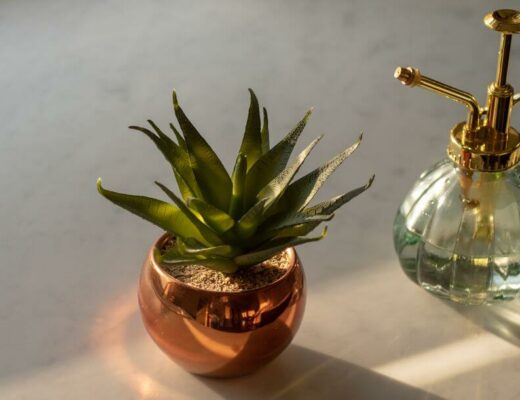The String of Hearts, also known as Ceropegia woodii, is a semi-succulent plant that has really skyrocketed in popularity! A perfectly cascading plant, String of Hearts is so delicately romantic. When given proper care and time to mature, this plant tumbles out and over the sides of pots creating a botanical curtain.
The leaves on a String of Hearts aren’t the only attraction. Its flowers, which bloom in late summer into fall, are also striking. The blooms have a very distinct tubular shape and are a light pink or magenta in color. While the flowers are very small, they add a fun addition to this already quirky plant!
Not only is this plant a joy to look upon but it is relatively easy to care for as an indoor plant! If you are interested in becoming a String of Hearts plant parent, be sure to check out our post on how to care for a String of Hearts!
Most people are familiar with the most common specimen, which is just simply named The String of Hearts. Did you know that there are more?! Let’s take a look at the Ceropegia woodii and its wonderfully unique String of Hearts varieties that you definitely need to know exist!
1. String of Hearts/Ceropegia woodii
The one that started all the craze, the Ceropegia woodii! This plant is a flowering member of the Apocynaceae family native to Zimbabwe, Eswatini and South Africa. It was discovered in 1881 on the tall Groenberg Mountain in South Africa and the rest is history.

The String of Hearts has chubby, thick leaves with a striking marbled design of dark green and cream. Take a look on the underside of the leaves and you will be delighted to find a rich purplish-brown coloring. The leaves grow in pairs on opposite sides of the slim vine.
All String of Hearts varieties enjoy long exposure to bright, indirect light. This kind of light exposure is a requirement if you want to enjoy its signature colors and blooming flowers!
The String of Hearts is a hardy trailing plant that thrives on neglect, though that doesn’t mean it can be totally forgotten about! It is important to completely drench the soil when watering and to allow the excess water to drain out before replacing it in its home.
Don’t re-water until the top three inches of soil are bone dry to the touch. Because The String of Hearts has a delicate root system, it is very susceptible to root rot!
It is easy to propagate a String of Hearts. Click here to read our post that will guide you through the steps of propagation.
2. String of Spades/Ceropegia woodii ‘Heartless’
The String of Spades is another type of String of Hearts. It is a playful variety with elongated heart shaped leaves that closely resemble the spade on a deck of cards. This String of Hearts variety has bright green leaves with thin, light creamy green veins, giving it a much less marbled look than the original.
Another unique, distinguishing trait of the String of Spades is how its leaves grow from the stem. In other varieties, leaves curve upwards and away from the stem on fine petioles. Leaves on a String of Spades grow flush with their stems.
While the String of Spades has been known to grow a bit slower than other varieties, you will still be able to enjoy a mature vine length over seven feet!
To best support the growth of your String of Spades, and all other varieties, I suggest planting in commercial succulent or cactus soil. This kind of mixture will provide its delicate roots with a loose, breathable environment and help prevent root rot.
3. String of Hearts ‘Silver Glory’/Ceropegia woodii ‘Silver Glory’
I love this String of Hearts variety both for its cute shape and bold color. When compared to the original String of Hearts’ shape, the Silver Glory flaunts a chubbier, rounder silhouette similar to that of an apple or a pumpkin. It is even reminiscent of a kidney bean!

As its name would suggest, the Silver Glory String of Hearts is known for its stunning silver stain on the top side of the leaves. The silver is faintly marbled with a green hue similar to that seen on other varieties.
A deep, muted green finely lines the margins of each leaf creating a bold border. This green can also be seen cutting the leaves in half down the main vein.
4. Variegated String of Hearts/Ceropegia woodii variegata
While leaves’ shape are reminiscent of the original String of Hearts, this variegated String of Hearts variety displays very different colors! Because of these colors, this fourth type of String of Hearts on this list is highly sought after.

Leaves are silvery green in the center that transitions to a rosy pink/purple along the margins. Consistent, bright indirect light will allow these pinks and purples to really shine.
Like all varieties of the String of Hearts, do not house your C. woodii variegata in high humidity areas of your house, such as the bathroom, or in terrariums. When watering, be cognizant to not allow water to flow onto the leaves and stems. This practice can attract pests and lead to disease. Use a watering can with a long spout and aim only at the base of the plant to fully saturate the soil.
5. String of Arrows/Ceropegia woodii ‘String of Arrows’
Another noteworthy String of Hearts variety is the String of Arrows. With slim, pointy leaves it’s no wonder how this plant got its name. Mainly a deep emerald green, the leaves have a fine silvery vein pattern on top.
A great selling point (do we need any more?) is that all String of Hearts plants are non-toxic to humans and pets. While this is the case, I still like to play it safe around curious hands and mouths to prevent any unknown reaction. It is, however, comforting to know that this is a relatively safe plant to have indoors.
6. String of Hearts ‘Orange River’/Ceropegia woodii ‘Orange River’
Often regarded as the rarest and most difficult to find String of Hearts variety, the ‘Orange River’ has some notable differences from the others. The leaves are triangular and are a shiny, vibrant green. Unlike other varieties, ‘Orange River’ doesn’t have a distinct veining pattern nor does it have marbled coloring.
When given adequate amounts of bright, indirect light, you can expect your ‘Orange River’ to live up to its name and blush a faint orange.
This type of String of Hearts will not do well with direct sunlight exposure, especially during the hottest hours of the afternoon. You can however slowly gradually introduce your plant to direct sunlight in the morning and evening hours. Doing so will actually provide your plant with “good stress” and encourage a brighter hue of orange to emerge!
7. String of Needles/Ceropegia linearis
Ok, this one technically is not a Ceropegia woodii variety but is closely related as it is a different species but within the same genus. It also grows similar to the aforementioned varieties and is a unique plant to add to your collection.

Thin, needle shaped feathery leaves cascade down a thin stem. All foliage is a bright, light green. If you look closely, you will note that this species of Ceropegia is slightly variegated with a light creamy green.
The String of Needles requires care that is similar to the other different types of String of Hearts plants. It does best when given minimal amounts of water because it best mimics its natural habitat. This plant also prefers bright but indirect light.
An important difference between the String of Needles and other types of String of Hearts is that it is considered slightly toxic, so please keep out of reach of kids and pets. Minor gastric upset such as vomiting or diarrhea may occur with ingestion. If large amounts are suspected to have been ingested, symptoms may become severe and medical help should be obtained.
Wrapping Up
I hope this list of String of Hearts varieties gives you a couple new ideas for plants that you are excited to add to your collection. Most commonly grown in hanging pots to show off its signature draping vines, any variety of String of Hearts will add a charming touch to your home!




